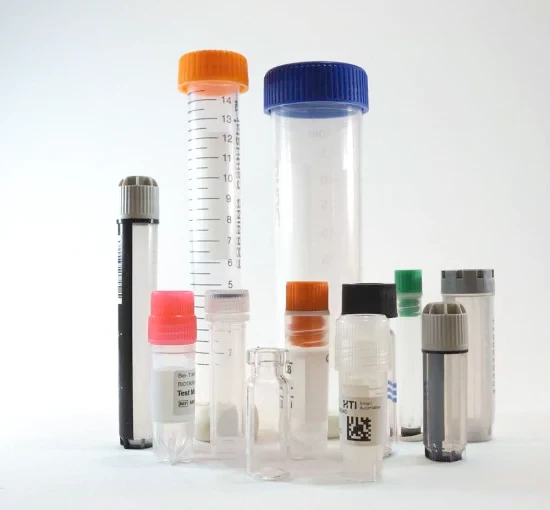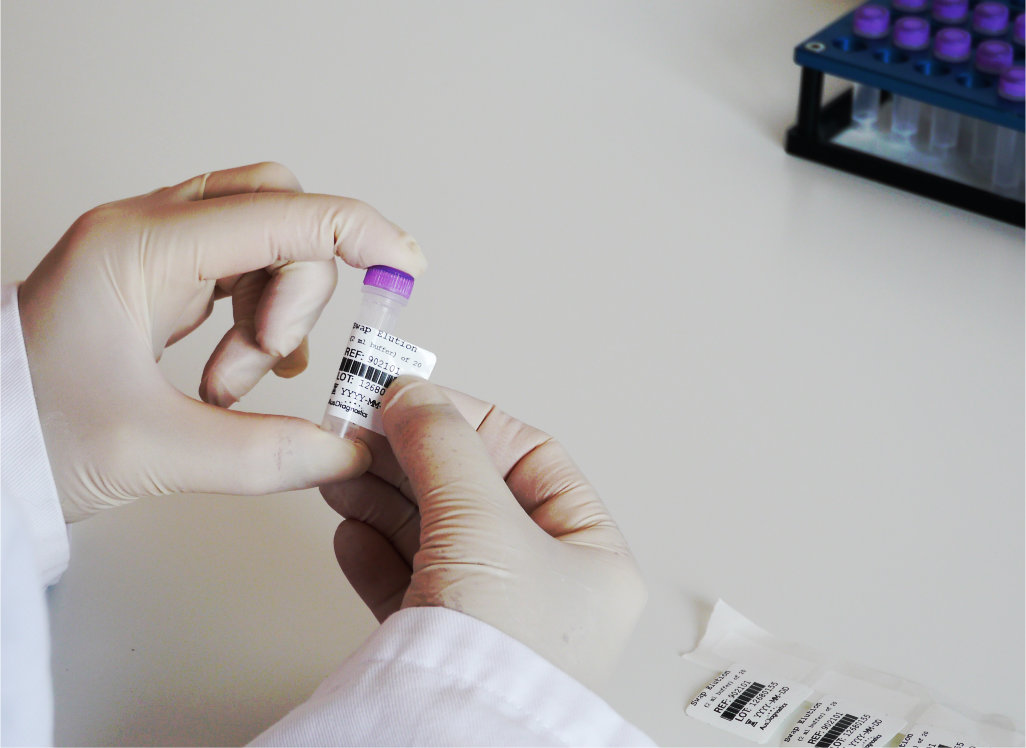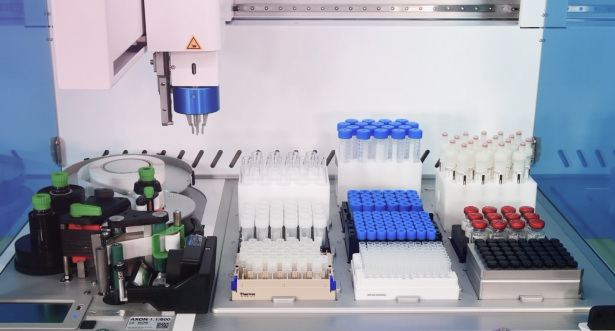Efficient tube labeling: from pen marking to fully automatic labeling
Label selection and application: Materials, methods and integration into LIMS
The marking or labeling of tubes has become very important in modern laboratories. Automated labeling offers numerous advantages, especially in industries that are subject to GLP guidelines or the “Principles for Safeguarding Good Scientific Practice”, as precise labeling is essential.
There are various methods available for labeling tubes.
This article offers insights into technologies and solutions for laboratory technology, from the selection of the printing process, material recommendations and the integration of labeling into a LIMS:
- Ink-jet printing process:
When labeling the tubes directly using inkjet printing or laser marking, a previously applied layer is specifically removed. - Thermal transfer printing:
However, the most commonly used process, due to its simplicity, is thermal transfer printing. The label is applied to a label that is then attached to the tube. In this process, a black dye is usually transferred from a ribbon to a white label using a print head and targeted heat pulses. Transparent and other colored labels and ribbons are also available as alternatives.

Examples of automated laboratory processes
1. material recommendations and options for labels in various applications
There is a wide range of material options for labels that can be considered by users. PE film labels are most commonly used as they are preferred due to their excellent resistance to common chemicals, ease of handling and cost.

Labeling of different tube types
Due to their rigidity, polypropylene (PP) labels are generally less suitable for labeling tubes, as they can detach themselves depending on the diameter of the tube.
It is important that the ribbon used is compatible with the label material and the respective application. Most label manufacturers offer suitable ribbon options. Resin ribbons are a suitable choice for PE film labels.
Self-laminated labels are available as an alternative solution. In addition to the actual labeling area, these also have a transparent area that is sufficient to enclose the tube. This protects the lettering particularly well, as it no longer comes into direct contact with the solvent thanks to the transparent film.
2. labeling and marking:
The choice of method and integration into the LIMS
Once the decision to use labels and codes has been made, the question of implementation arises. This depends on the number of tubes and the specific requirements and can be accomplished in various ways. The most important aspects to consider are the cover options and installation methods.
Where to buy labels
The labeling of tubes is crucial. Various methods are available depending on requirements, from pre-labeled tubes to on-demand printing.
Tubes labeled by the manufacturer
If all that is required is clear identification of the tubes used, for example with a barcode, tubes already labeled in advance by the manufacturer offer an uncomplicated solution. Many manufacturers offer this service for at least some of their tubes. However, you often have little influence on the type of labeling and the codes used.
Manual production of the label
However, if more and more specific information is required on the label, the labels themselves can be created. For this purpose, standard label sheets are printed using a standard laser printer. The labels must then be applied to the tubes manually. Another option is to have the labels produced by a specialized label printing company in order to obtain user-specific solutions.
On-demand printing
If on-demand data such as the date, batch numbers or special sample data is required on the label, there is no way around a dedicated label printer. At the same time, however, this opens up extended possibilities in terms of layout, additional information on the label and, in particular, integration into the laboratory process. Labels can often be generated directly from the laboratory information management system (LIMS).
3. label information and integration in LIMS
The amount of machine-readable information that can be accommodated in a code depends on the type of code used. Especially with “speaking” codes, there are quick limitations.
“Speaking” codes are solutions in which the actual information, such as the manufacturer, filling date or information on the processor and solvent, is already encoded directly in the barcode or 2D code. The advantage is that no shared database is required. Anyone who knows the specification can create and read the code.
Alternatively, the code can also be used exclusively to transmit a unique identification number . The actual information about the sample or tube is stored in a database. The identification number serves as the key for the corresponding data record. This procedure is generally used in conjunction with laboratory information and management systems (LIMS).
In addition to barcodes and 2D codes, a lot of other information can be applied to the label, such as plain text for the codes as well as pictograms, logos and other data.
4. attaching the labels to the tube: The possibilities
There are various methods for labeling tubes: Manual application, semi-automatic application, automatic application and integrated labeling. Each method has its own advantages and disadvantages and is used depending on the requirements and intended use of the tubes.

Manual labeling in the laboratory
1. manual attachment/application
The simplest method is to apply the label to the tube manually. The label is removed from the carrier material and glued to the tube by hand. The quality can be inconsistent, especially when labeling many tubes. Labels can be stuck on crookedly, have a difference in height or be creased. In the worst case, the label protrudes beyond the bottom of the tube, which can lead to instability or cause the machine to be unable to read the barcode. The manual work is also repetitive and tiring.
2. semi-automatic attachment/application
Label printers with a connected applicator, which are offered by various companies, provide a solution. The label is printed as required, automatically detached from the carrier tape and rolled onto the tube. The tubes are still prepared and removed manually.
3. automatic attachment/application
Manufacturers of specialized compact appliances go one step further. Here, the tubes are either pre-sorted in racks or provided individually from bulk material or large quantities via so-called “tube feeders”. The device automatically removes the tubes, feeds them to the labeler and applies the labels before returning the tubes. It can label a certain supply of tubes independently or compile a predefined set of tubes with the same label. This procedure is used, for example, in the pre-analytics department of a clinic when different blood tubes have to be prepared for a patient.

Automated labeling with the Sign
4. integrated labeling
With integrated labeling, the label is applied to the tubes during the entire process. It is possible to expand the labeling system with a filling module, so that the tubes can be labeled and filled directly. In this way, the labeling, filling and screwing steps can be carried out seamlessly in a single process sequence. This process is used, for example, in the filling of substances for the production of analysis kits. The empty tube is removed from the device, filled with the substance, closed with a lid provided and then labeled. It is not only possible to print a previously entered batch ID on the tube, but also the exact filling time or the consecutive number in the batch series if required.

Automated tube handling with integrated labeling, filling and screwing
4. machine readability – barcode and 2D code explained simply
A significant advantage of machine marking is the ability to apply machine-readable codes for fast and secure data capture using a handheld scanner or within the processing and analysis equipment.
A distinction is made here between a barcode and a 2D code:
The barcode is only suitable for relatively short pieces of information. There are variants that can only display numbers (e.g. Interleaved 2/5) and those that can also integrate letters and special characters (e.g. Code 128). The barcode has the advantage that it is easily recognized by common scanners and does not show any distortions when correctly placed along the rotation axis of the tube. The disadvantage is the limited information capacity of the code, as usually only 10 or 12 digits or letters fit on the label of a tube.
2D codes (e.g. QR codes), on the other hand, do not have this disadvantage. They offer a much higher density of information. With the data matrix code, up to 3116 digits or 2335 characters (ASCII 1-255) can be encoded in a very small space, whereby the symbol size varies depending on the amount of data. However, when marking round or curved surfaces, there is always a distortion of the two-dimensional code, which limits the amount of information available or the size of the code that can be used. In addition, reading 2D codes (e.g. data matrix, QR code) requires special 2D barcode scanners.
Conclusion
Successful sample labeling requires careful coordination of material, method and integration.
| Aspect of tube labeling | Recommended method/solution | Key considerations |
|---|---|---|
| Label material | PE film labels | High durability, Easy handling, Cf. low costs, Risk of detachment with tubes due to film stiffness |
| Resin ribbons (for PE film labels) | Note compatibility with ribbon and LIMS | |
| Self-laminated labels | Additional protection against solvents thanks to transparent enclosing film | |
| Supply options for labels | Tubes labeled by the manufacturer | Simple labeling, limited control |
| Manual production of the label | High customizability, Manual effort |
|
| On-demand printing | Individual data, Label printer required, Integration in LIMS, Generate direct from LIMS, |
|
| Attaching labels to tubes | Manual attachment | Simple, but inaccurate |
| Semi-automatic mounting | Automation with manual removal | |
| Automatic attachment | High precision, Efficient mass labeling, Bulk material can be processed, Tube pre-sorting possible, |
|
| Integrated labeling | Seamless process, All processing steps possible in one process, Data such as filling time, consecutive number possible, High flexibility |
|
| Machine readability of codes | Barcode (barcode) |
For brief information, Easily recognizable, Hardly/no distortions, |
| 2D codes (data matrix, QR code) |
High information density, Special scanners required, Distortions limit size, |
The labeling of sample material or test substances in tubes can be easily carried out using simple tools.
Printing and applying the label to the tube can be carried out separately. Special laboratory equipment is available to label a large number of tubes, create labels on demand or process the entire tube including labeling. It is also possible to record process data on the label.
The selection of the concept, the label material, the label layout with 1D and 2D codes and the integration into the laboratory workflow should be carefully coordinated, as they determine whether the sample labeling is successful.
X-TubeProcessor®_Sign
Versatile labeling
Laboratory tubes and vials Labeling has never been so easy and flexible.
Label different tube types in one step and manage label design and data flexibly from any workstation.
The Sign is more than just a laboratory label printer and adapts to your processes.

-
Labeling & marking
-
Efficient and flexible data management
-
Label a variety of tube types and racks
-
12 racks for different or identical tube types
-
Simple label design and data creation from any workstation

